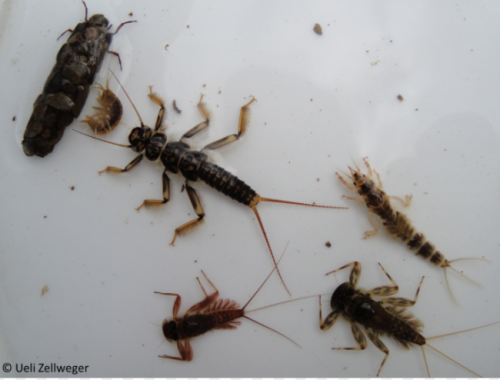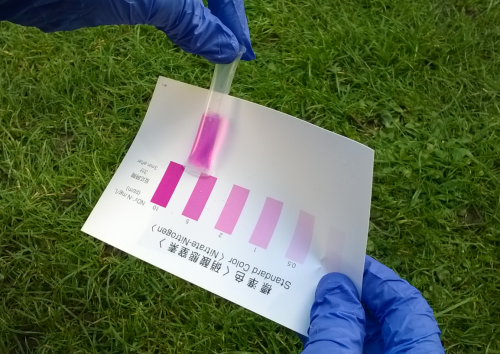Monitoring the water quality of rivers, streams, ditches and ponds can identify sources of pollutants in your area, and help investigate how these levels vary with time and conditions. The most accurate, professional sampling equipment for water chemistry is expensive to buy and maintain, but there are some cheaper and more fun ways to keep track of your water quality!
Whether you are monitoring river invertebrates, pond invertebrates or nitrates and phosphate in water, a systematic sampling regime must be in place if you wish to evaluate changes over time. This means that sampling locations need to be identified before sampling begins, the frequency of the sampling decided in advance, and then samples taken repeatedly from all locations in accordance with the predetermined sampling regime.
River invertebrates
Freshwater invertebrates are a great indicator of water quality and they can be easily surveyed at the riverside. Each type of invertebrate has a different tolerance ‘score’ to pollution, and riverflies are generally quite sensitive to poor water quality. So all you have to do is tot up the different types and abundances of riverflies to generate an overall score for the site. The Riverfly Partnership coordinates a freshwater invertebrate survey network across many rivers and streams in the UK. To get you started, they can provide groups with a one-day Riverfly Partnership workshop which includes short presentations, practical demonstrations and active involvement by participants at the riverside. You’ll need a freshwater invertebrate sampling kit and someone to act as the data collector/representative for the cluster. To book a workshop, get in touch with the national Riverfly Partnership ‘Anglers River Monitoring Initiative’ coordinator, Ben Fitch, at ben@riverflies.org
Mayflies, stonefly and caddisfly © Ueli Zellweger, Total Flyfisher
Pond invertebrates
As with rivers, invertebrates in ponds can indicate the quality of the water and habitat. The Freshwater Habitats Trust has set up an easy national pond survey called the Big Pond Dip which anyone can learn to do. Using their method, and the same kit as in the Riverfly method above (or even with just a sieve and makeshift tray) you can collect a sample of invertebrates from a pond and identify them. Then you fill in the form to tot up the scores of invertebrates present to give a pond quality score.
If you want to investigate further, the Freshwater Habitats Trust’s PondNet page lists a range of species-specific or in-depth pond quality surveys that you can do. Bear in mind that many of these require some skill and training (or even a licence, as in the case of protected species such as great crested newts).
Nitrate and phosphate in water
Nitrate and phosphate can have negative impacts on a watercourse, by causing enrichment of the water. These nutrients enter watercourses at ‘point’ sources such as a septic tank, or ‘diffuse’ sources such as a large area of arable land. Taking water samples from rivers and ponds can help identify where potential sources are so you can address them, and keep track of levels.
If you don’t want to commission professional water quality surveys, or buy pocket-meters (which require regular calibration, servicing and purchase of calibration solutions), you can use a PackTest. The Freshwater Habitat Trust lists suppliers of water quality equipment here. PackTests come in boxes of 40-50 and have a shelf life of 12 months.
A PackTest involves simply syringing a sample of water up into the supplied reagent tube, and comparing the resulting colour to a chart to obtain a range reading. This is a method used nationally by the Freshwater Habitats Trust’s Clean Water for Wildlife project. They have made a helpful video which demonstrates the water sampling process. When you have got results for your watercourses, you can help the Freshwater Habitats Trust build a picture of water quality across the country by entering your PackTest kit results online.
Samples should not be taken after extreme weather events such as storms or drought, or after disturbance of the substrate; instead they should be taken after the water has had time to settle back to normal (minimum two weeks).
A nitrate testing kit © Freshwater Habitats Trust


